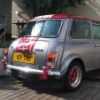Hi,
I just did this on my ECU as I knackered the old one by doing something silly. The part itself was pretty damn expensive at 90 quid, but other than that it didn't cost me anything. I am lucky to work in a place with access to microscopes and good soldering equipment, but this could be done with any reasonable soldering iron and good eyesight, it's a very simple soldering job really.
After thinking about it... this could be done much cheaper with a little but of research into what the pins are on the original. It is a simple 3 pin MAP sensor. The Pins are +5v / Signal / Ground. I just don't know which is which, but it's probably findable somewhere. All you need to do is find a basic 3 wire MAP sensor, which are everywhere, and solder wires into the original pin locations and route them out the original nipple location. You can then mount the 3 wire MAP sensor somewhere in the engine bay to your liking.
Basically the steps are as follows. I labelled the pictures, but they are pretty self evident.
- Remove the ECU.
- Use a T-15 tamper proof bit to unscrew the back cover.
- When you remove the lid you will see the "bottom" side of the circuit board.
- You will be able to identify the 3 pins of the map sensor inside the 4 black plastic plugs. Mine had been done before (2005) so looked a bit crusty as they didn't clean the flux off.
- The board is covered in a thick layer of conformal coating, this can be gently scraped away with a dull tweezer.
- For turning the board over I placed something into the screw holes to act as stand-offs. In this case some tapered plastic dispensing tips.
- The MAP sensor is obvious, if you can't find it put the cover back on and give it to somebody else.
- Carefully remove the connecting rubber hose, and check it for cracks and splits.
- Back to the bottom side, use solder braid and flux, and soak up the original solder on the joints. This takes time, and be very careful not to overheat the board or you could damage the tracks or lift a pad. It's game over then.
- Once the solder is gone and the pins look to be free, squeeze the black locating tabs and push them out of the board. The MAP sensor should come out. At this stage I had some solder stuck in the holes, so I used cutters and cut the pins. This let me get rid of the sensor and remove the pins with the soldering iron and a tweezer. A solder sucker is also useful at this point to clear out the holes.
- Wash up the mess with some alcohol and a cotton swab.
- Fit the new sensor in the board.
- Solder 3 pins. Trim them after to avoid the chance of them touching the back cover.
- Clean again.
- Re-Fit the rubber hose - I nearly forgot.
- If you really want you could put some RTV silicone over the pins for moisture protection.
- All you have to do now is bolt it all back up and re-fit to the car.
Finally, I tested my old sensor with a syringe, it didn't hold any vacuum. I don't recommend doing this with the new sensor, as this is essentially how I buggered it up in the first place. I also opened up the old sensor for a look. It was full of condensed fuel vapor. Under the microscope, the silicone inside was torn. memsfcr was confirming there was no output from the MAP sensor. Replacement back to normal.
Attached Files
Edited by madazv8, 04 May 2023 - 12:47 PM.
















